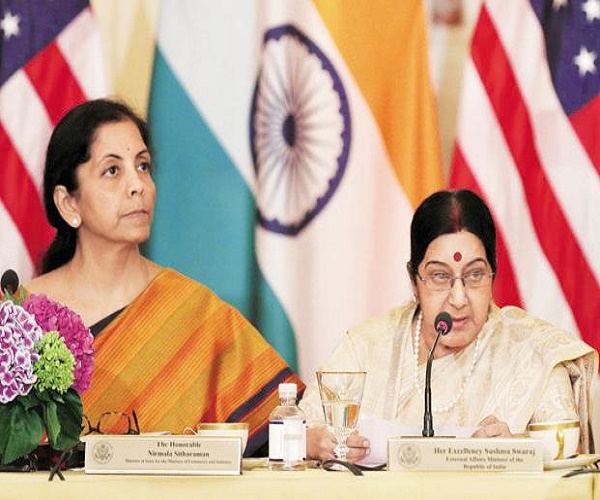In the May 2014 Lok Sabha elections, the percentage of women MPs remained rose from 10.9% to a grand 11.4% and the new Council of Ministers included seven women ministers (six of cabinet rank including the Minister for External Affairs) out a total of 46 sworn in on May 26, 2014. Seven out of 46 is about 15%, but this was still made out to be a shattered glass ceiling, not least because External Affairs had been given to a woman. How good have women had it in electoral politics since 2014? As we prepare for Lok Sabha elections in 2019 (or earlier), and with a government that remains in campaign mode, it is worthwhile making an assessment.
In this month’s election results from Meghalaya, Nagaland and Tripura, women fared poorly. In Meghalaya, 33 women joined the contest for 60 seats and only three have won. Ten of the candidates were Independent and with seven women candidates, the Congress had the most gender-diverse list. Two of their candidates one, and Agatha Sangma from the National People’s Party (NPP). In Nagaland, local government quotas for women have been contentious. In this election, only five women contested and all of them lost. Who nominated them? Two were nominated by the NPP, one was an Independent and one each were nominated by the BJP and the Nationalist Democratic Progressive Party. In Tripura, twenty-four women contested the elections and only three won. The CPI(M) nominated seven of these candidates, the Congress six and the BJP four. Two of the three who won were from the BJP.
The simplest measure of women’s success in politics is inclusion—that is, how many women are nominated to contest elections. In 2014, women made up 8% of those contesting the elections and 11.4% of those who won. In some major Assembly elections since then, the percentage of those contesting has hovered between 7-9 with the exception of West Bengal at 10.9%. Women have crossed 10% of winners in seven states which are a motley crew in terms of other indicators: Bihar, Chhattisgarh, Haryana, Madhya Pradesh, Punjab, Rajasthan, West Bengal and Puducherry. This challenges both the idea that better social indicators are a predictor of women’s participation and that education somehow trumps patriarchy. (Let us for now ignore the pathetic fact that ‘better’ is still not quite 15%.)
What makes it possible for more candidates to get elected in states like Haryana and Rajasthan which are not generally associated with gender-inclusive practices and policies? Party support, in the form of money, posters or flyers, campaign staff or transport, and of course, the visit of star campaigners, may have helped. Lack of money is one of the biggest obstacles women face in contesting elections, which everywhere in the world are becoming more expensive. It is hard for women to raise money for many reasons—for instance, the lack of access to capital and credit, the absence of support networks given that they uproot themselves and move to a new place after marriage and the need to also pay for someone take over their care responsibilities.
But remember, it is still barely 15% and the same political parties resist the Women’s Reservation Bill. On balance, Panchayat reservations have yielded good results. Despite the pessimistic predictions that men would nominate and manipulate relatives, many women have availed the opportunity to step out and seek political careers. Moving from Panchayats to Assemblies, they discover how reluctant their male colleagues—even mentors—are to share electoral opportunities with them. This is the most important argument for state and national quotas for women. Quotas are intended to be a transitional feature (although they become entrenched for political reasons) but they are an excellent way to force inclusion in the face of a reluctant political (or social) class.
One workaround would be for parties to voluntarily adopt a minimum quota (33% to 50%) and nominate women candidates accordingly. Parties say they will but challenged, their response is, “Where are the qualified women?” They are everywhere, but invisible to those who do not wish to see. Women serve families, neighbourhoods and community organisations. They work in offices; manage family stores; operate chit funds and other self-help solutions; run cottage or larger enterprises and are one-woman businesses as informal entrepreneurs. They travel miles for water, wood and work, and they interact with strangers to negotiate for utilities, credit and rights. Women work with budgets, understand policy and law and have the ability to comprehend and reconcile a wide spectrum of needs around them. This is not counting the thousands of more traditionally ‘qualified’ women in universities, offices and even, Panchayats and Municipal Corporations.
“Yes, but they will not join politics.” Why? Women, and their families, face stigma, rape threats, calumny and worse when they stand for elections. Indeed, they are viciously trolled even for publicly expressing an opinion. This is why the Prajnya Gender Equality Election Checklist recommends that those who indulge in misogynistic speech and those charge-sheeted for sexual and gender-based violence offences should not be offered party nominations until cleared by the courts. The levels of hate speech against women have arguably never been higher and the universal access to social media amplifies attitudes that push the limits of free speech.
The Checklist asks parties to nominate more women; support women’s election campaigns; make misogynistic speech a disqualification for elections; and, reject those charge-sheeted for sexual and gender-based violence. Parties are urged to address gender issues in their manifestos and campaigns. Monitoring elections and campaigns along these lines is the smallest and easiest step of the journey when neither parties nor voters seem to actually care. The task ahead of the upcoming elections is to make gender equality an election issue and hold parties accountable. But will we try, or because it is a formidable task, will we choose to be content with crumbs, even obsequiously grateful? #KhabarLive







